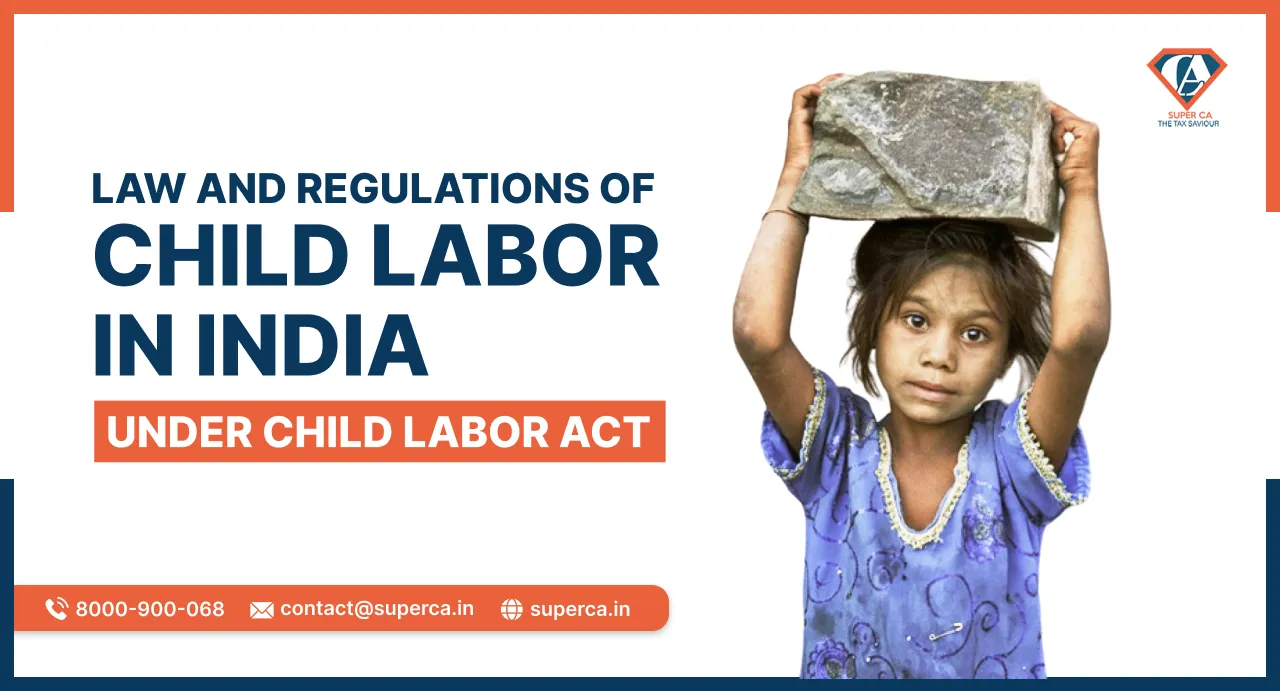Laws and Regulations of Child Labour in India
- Posted By SuperCA
- On 20 May

Child Labour has been of the most persistent obstacles that our countries faces. Child Labour continues to take away the childhood of innumerable children around the country. Child Labour ends up depriving children of their lively childhood and takes a toll on their mental and physical growth and development. This indirectly creates a hindrance in the development of a nation. There are various reasons for child Labour in India like poverty, lack of basic facilities, economic imbalance, lack of proper education and schools that force children from poverty-stricken houses to give up their lives at an early age and involve in Labour for inadequate pay. This is a type of rights violation and exploitation of employee. Recently, an increase in child Labour has been seen in urban areas due to massive migration in search of jobs.
Child Labour was declared as illegal by the government ages ago but it still prevails in our Country. The government of India has devised many rules, regulations and laws to eradicate this pervading issue and has also started various schemes in India to provide children with a better and hopeful future. One of the main pieces of legislation that prevents children from involving in child Labour is the Child and Adolescent Labour (Prohibition and Regulation) Act, 1986. Through this blog, let us know about the laws and regulations of child Labour in India along with the key Provisions of The Child Labour Act in order to determine its implementation and effectiveness.
The Key Provisions of Laws and regulation of Child Labour via Child Labour Act
The Child and Adolescent Labour (Prohibition and Regulation) Act, 1986:
This is commonly referred to as The Child Labour Act and was issued by the government on 23rd December to particularly point out and prohibit the involvement of children in any jobs and the engagement of adolescents in hazardous working conditions and processes. The Child Labour Act is one of the most important Laws and Regulations of Child Labour in India. The various provisions of this act are listed below:
- In relation to child Labour, the act introduces various important terms like child, adolescent, establishment and workshop. The Free and Compulsory Education Act is used to determine the age of a child if not specified. Usually, the word ‘child’ refers to someone below the age of 14 years.
- Under this Act a Central Government Technical Advisory Committee is established that ensures comprehensive coverage and identifies those jobs and processes that may constitute child Labour. This advisory also sets the laws and regulations of child Labour for the working hours, which may be three hours and maybe six hours a day.
- Any disputes that occur regarding the actual age of a child are the responsibility of the medical authorities. Violation of the Child Labour Act may lead to a maximum of two-years in prison along with penalties. There are exemptions to this rule too i.e. children working in family business are exempted from this rule.
- Any offense related to the Sections 3 and 3A of the Child Labour Act is considered perceptible which allows immediate action from the police without any approval of a higher authority.
- This Act also establishes a Child and Adolescent Fund, which is aimed at supporting the betterment of such children and help them in rejuvenating from the exploitation that they faced for the past years.
In a nut shell, it can be assumed that the Child Labour Act which is a part of the laws and regulations of child Labour, plays an important role in eradicating child Labour with various provisions that help in the regulation, punishment, framing legal frameworks and rehabilitation. But there are a few areas that may need a little improvement like eradicating income differences and poverty and verifying the credibility of age certificates to make sure that the children can have a hopeful future.
Various Causes of Child Labour
There are a lot of social and economic factors and failures of our system that lead to child Labour despite the formation of various laws and regulations of child Labour. The reasons are listed below:
- Poverty: Poverty is definitely one of the major driving forces for child Labour. The children from poor households often end up doing Labour. Their lack of resources forces the children to help the family by engaging in child Labour.
- Lack of Education: the restricted access to education, particularly in rural areas is also one of the root causes of child Labour. When there is a lack of quality education for children in rural areas they often engage in Labour activities.
- Cultural and Social Factors: Some foolish social and cultural standards push children towards child Labour.
- Weak Implementation of Laws: In spite of the presence of various laws and regulations for child Labour, the proper implementation is still lacking. Inadequate enforcement of laws contributes to the persistence of child Labour.
- Migration and Urbanization: The migration of people from rural to urban areas and the high pace of urbanization leads to a demand of cheap Labour. In this situation, the children from poor families often end up being exploited and forced into doing Labour.
- Informal Sector: The informal sector, where the laws and regulations of child Labour are sometimes not effectively implemented has a high ratio of child Labour.
- Demand for Cheap Labour: Due to economic factors, the demand for cheap Labour is witnessed and this leads to the exploitation of children as they are paid less and are made to work more in extreme conditions.
All of these causes of child Labour have been addressed by the government and proper laws and regulations of child Labour have been administered by the government. The eradication of child Labour is a time taking process and needs consistent effort not only from the government but also from the people of our country. The laws and regulations of child Labour need to be implemented and enforced properly to eradicate child Labour and provide children a better future.





